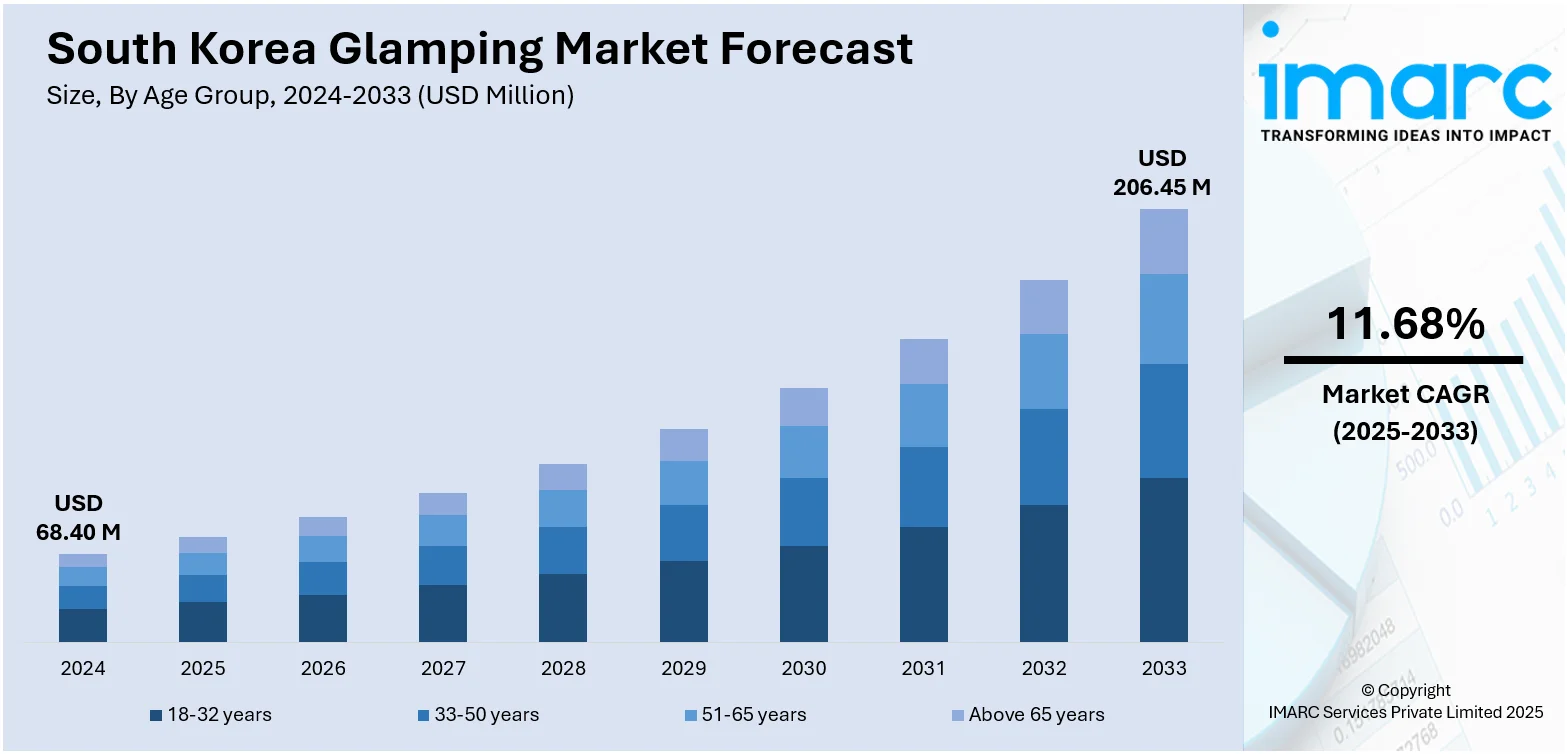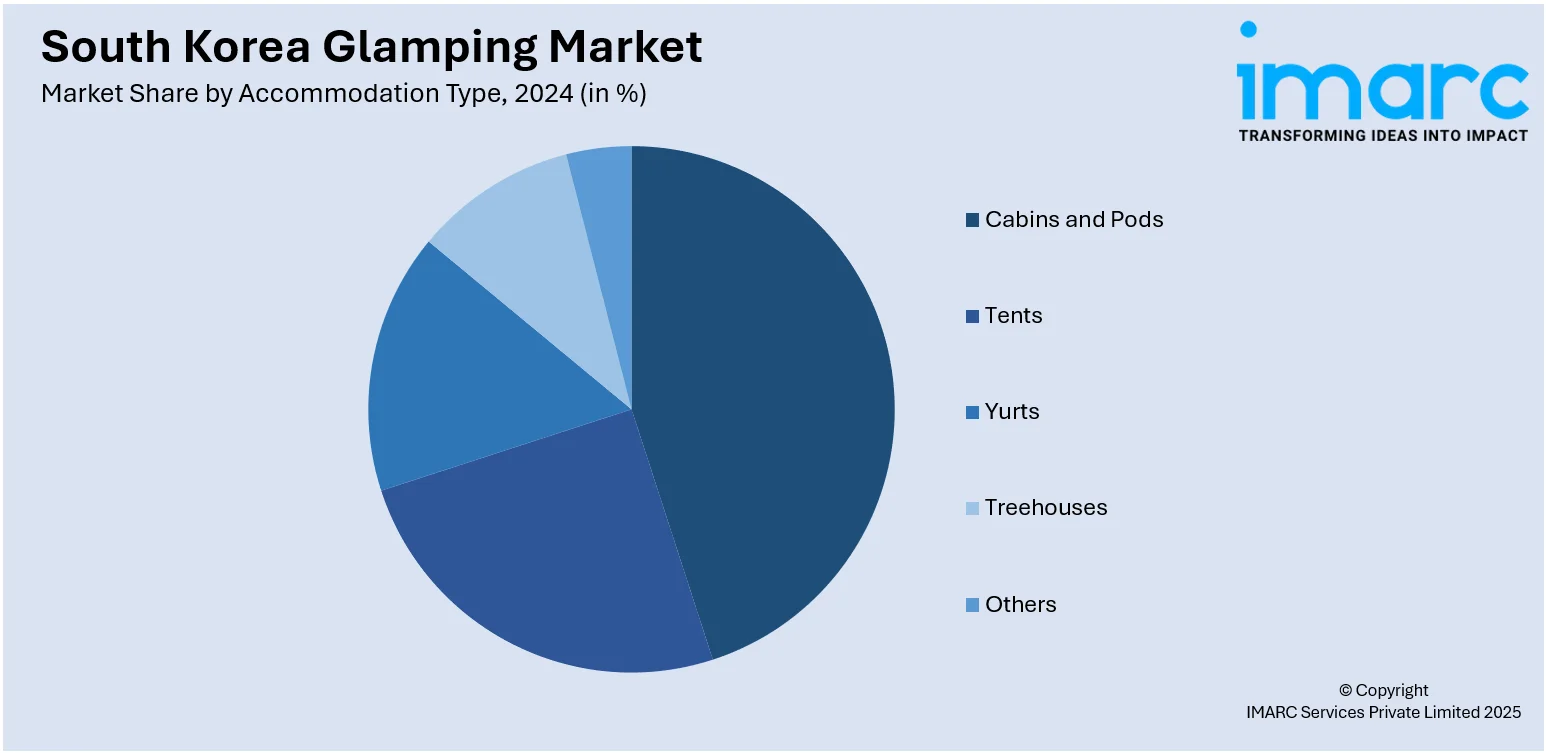
South Korea Glamping Market Size, Share, Trends and Forecast by Age Group, Accommodation Type, Booking Mode, and Region, 2025-2033
South Korea Glamping Market Overview:
The South Korea glamping market size reached USD 68.40 Million in 2024. The market is projected to reach USD 206.45 Million by 2033, exhibiting a growth rate (CAGR) of 11.68% during 2025-2033. The market is propelled by the growing domestic demand for nature-based leisure activities as urban residents increasingly seek short getaways to escape densely populated environments. Moreover, rising disposable incomes and growing interest in wellness and experiential travel are encouraging consumers to opt for upscale glamping options that combine comfort with outdoor adventure. Apart from this, government initiatives promoting regional tourism and eco-friendly accommodations are further augmenting the South Korea glamping market share.
|
Report Attribute
|
Key Statistics
|
|---|---|
|
Base Year
|
2024
|
|
Forecast Years
|
2025-2033
|
|
Historical Years
|
2019-2024
|
| Market Size in 2024 | USD 68.40 Million |
| Market Forecast in 2033 | USD 206.45 Million |
| Market Growth Rate 2025-2033 | 11.68% |
South Korea Glamping Market Trends:
Rising Disposable Income and Premium Leisure Spending
The rise in disposable incomes among South Korea’s middle-class population is significantly influencing demand for premium leisure activities such as glamping. As per industry reports, disposable personal income in South Korea rose from KRW 2349203.90 Billion (approximately USD 1.77 Trillion) in 2022 to KRW 2438286.40 Billion (about USD 1.84 Trillion) in 2023. It reached an all-time high of KRW 2588759.30 Billion (around USD 1.95 Trillion) in 2024. With greater financial flexibility, consumers are increasingly inclined to allocate spending toward non-essential lifestyle experiences that offer both comfort and novelty. Glamping meets this demand by combining the allure of nature with amenities typically associated with upscale hospitality, such as temperature-controlled interiors, private bathrooms, curated meal options, and entertainment facilities. This is particularly appealing to dual-income households and younger professionals who seek unique weekend getaways without compromising on convenience. Additionally, higher income levels have expanded the customer base beyond early adopters, allowing glamping operators to diversify offerings across price points, from luxury cabins to affordable modular tents. Besides, the willingness to pay a premium for quality experiences has led to the proliferation of theme-based and curated packages, further enhancing the perceived value. In this context, rising disposable income continues to act as a foundational driver, accelerating innovation and South Korea glamping market growth.

To get more information on this market, Request Sample
Growth of Domestic and Inbound Tourism
The expansion of both domestic and inbound tourism in South Korea is contributing substantially to the development of the glamping market. In a 2024 survey conducted in South Korea, approximately 68.8% of respondents indicated their intention to embark on domestic travel within the upcoming months. This strong inclination toward local tourism reflects a broader shift in consumer behavior, where convenience, accessibility, and safety are prioritized. As a result, the glamping sector is witnessing increased interest, particularly from urban dwellers seeking short, comfortable getaways in natural settings without the complexities of traditional travel planning. Glamping provides an attractive alternative to conventional accommodations, especially in scenic regions such as Gangwon-do, Gyeonggi-do, and Jeju. Furthermore, improved transportation infrastructure, including high-speed rail and expressways, has enhanced accessibility to these natural locations, further encouraging weekend and holiday travel. Simultaneously, the recovery of inbound tourism has led to a renewed focus on experiential lodging that caters to international tastes. In addition to this, government campaigns promoting regional tourism have also played a role in drawing attention to glamping sites as part of broader travel itineraries. As tourism continues to grow, glamping is becoming a preferred accommodation choice that meets the evolving expectations of both domestic and international visitors.
South Korea Glamping Market Segmentation:
IMARC Group provides an analysis of the key trends in each segment of the market, along with forecasts at the country and regional levels for 2025-2033. Our report has categorized the market based on age group, accommodation type, and booking mode.
Age Group Insights:
- 18-32 years
- 33-50 years
- 51-65 years
- Above 65 years
The report has provided a detailed breakup and analysis of the market based on the age group. This includes 18-32 years, 33-50 years, 51-65 years, and above 65 years.
Accommodation Type Insights:

- Cabins and Pods
- Tents
- Yurts
- Treehouses
- Others
A detailed breakup and analysis of the market based on the accommodation type have also been provided in the report. This includes cabins and pods, tents, yurts, treehouses, and others.
Booking Mode Insights:
- Direct Booking
- Travel Agents
- Online Travel Agencies
The report has provided a detailed breakup and analysis of the market based on the booking mode. This includes direct booking, travel agents, and online travel agencies.
Regional Insights:
- Seoul Capital Area
- Yeongnam (Southeastern Region)
- Honam (Southwestern Region)
- Hoseo (Central Region)
- Others
The report has also provided a comprehensive analysis of all the major regional markets, which include Seoul Capital Area, Yeongnam (Southeastern Region), Honam (Southwestern Region), Hoseo (Central Region), and others.
Competitive Landscape:
The market research report has also provided a comprehensive analysis of the competitive landscape. Competitive analysis such as market structure, key player positioning, top winning strategies, competitive dashboard, and company evaluation quadrant has been covered in the report. Also, detailed profiles of all major companies have been provided.
South Korea Glamping Market Report Coverage:
| Report Features | Details |
|---|---|
| Base Year of the Analysis | 2024 |
| Historical Period | 2019-2024 |
| Forecast Period | 2025-2033 |
| Units | Million USD |
| Scope of the Report |
Exploration of Historical Trends and Market Outlook, Industry Catalysts and Challenges, Segment-Wise Historical and Future Market Assessment:
|
| Age Groups Covered | 18-32 years, 33-50 years, 51-65 years, Above 65 years |
| Accommodation Types Covered | Cabins and Pods, Tents, Yurts, Treehouses, Others |
| Booking Modes Covered | Direct Booking, Travel Agents, Online Travel Agencies |
| Regions Covered | Seoul Capital Area, Yeongnam (Southeastern Region), Honam (Southwestern Region), Hoseo (Central Region), Others |
| Customization Scope | 10% Free Customization |
| Post-Sale Analyst Support | 10-12 Weeks |
| Delivery Format | PDF and Excel through Email (We can also provide the editable version of the report in PPT/Word format on special request) |
Key Questions Answered in This Report:
- How has the South Korea glamping market performed so far and how will it perform in the coming years?
- What is the breakup of the South Korea glamping market on the basis of age group?
- What is the breakup of the South Korea glamping market on the basis of accommodation type?
- What is the breakup of the South Korea glamping market on the basis of booking mode?
- What is the breakup of the South Korea glamping market on the basis of region?
- What are the various stages in the value chain of the South Korea glamping market?
- What are the key driving factors and challenges in the South Korea glamping market?
- What is the structure of the South Korea glamping market and who are the key players?
- What is the degree of competition in the South Korea glamping market?
Key Benefits for Stakeholders:
- IMARC’s industry report offers a comprehensive quantitative analysis of various market segments, historical and current market trends, market forecasts, and dynamics of the South Korea glamping market from 2019-2033.
- The research report provides the latest information on the market drivers, challenges, and opportunities in the South Korea glamping market.
- Porter's five forces analysis assist stakeholders in assessing the impact of new entrants, competitive rivalry, supplier power, buyer power, and the threat of substitution. It helps stakeholders to analyze the level of competition within the South Korea glamping industry and its attractiveness.
- Competitive landscape allows stakeholders to understand their competitive environment and provides an insight into the current positions of key players in the market.
Need more help?
- Speak to our experienced analysts for insights on the current market scenarios.
- Include additional segments and countries to customize the report as per your requirement.
- Gain an unparalleled competitive advantage in your domain by understanding how to utilize the report and positively impacting your operations and revenue.
- For further assistance, please connect with our analysts.
 Request Customization
Request Customization
 Speak to an Analyst
Speak to an Analyst
 Request Brochure
Request Brochure
 Inquire Before Buying
Inquire Before Buying




.webp)




.webp)












